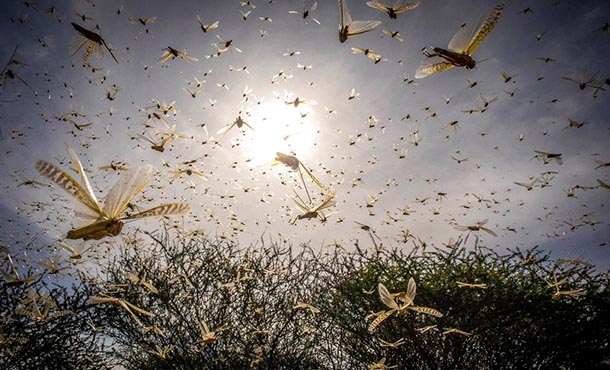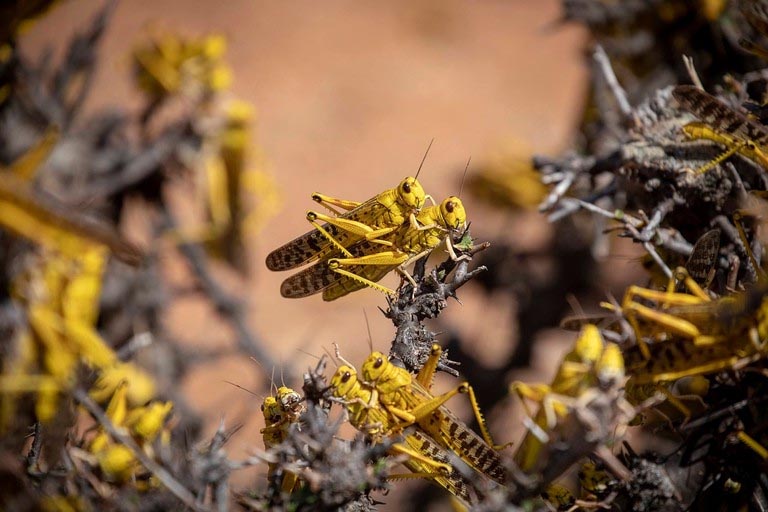
A locust swarm in northeast Kenya. The United Nations Food and Agriculture Organization has warned that the swarms already seen in Somalia, Kenya and Ethiopia could range farther afield. IMAGE: SVEN TORFINN/FAO
Penn State responds: App aids UN efforts to control Africa's locust infestation
A partnership with the UN enables Penn State researchers to rapidly respond to the locust crisis with an artificial intelligence tool that tracks the insects' spread
5/29/2020
By Sara LaJeunesse
UNIVERSITY PARK, Pa. — Billions of locusts are tearing across East Africa, destroying crops and putting some 19 million people at risk of severe food insecurity. The United Nations has called for a rapid response to this food-security threat. Through a memorandum of understanding with the Food and Agriculture Organization of the U.N. (FAO), David Hughes, Penn State professor of entomology and biology and creator of PlantVillage, an initiative to empower farmers with agricultural knowledge and technologies, is answering this call. With U.N. support, he and his colleagues are fast-tracking the creation of a mobile app that locates and tracks the insects in order to assist in early warning and targeted spraying efforts.
During a briefing at the U.N. headquarters on Feb. 10, U.N. Humanitarian Chief Mark Lowcock, said, “I’m calling on the countries concerned, the international community, the donors, to step up and to step up now. There is a risk of a catastrophe. Perhaps we can prevent it; we have an obligation to try. Unless we act now, we’re unlikely to do so.”
Leveraging the two parties’ complementary skills — Penn State’s expertise in artificial intelligence, cloud computing and app development and FAO’s experience in data analysis — Penn State signed a memorandum of agreement with the FAO in January to facilitate their collaborative work to directly address the locust problem.
“PlantVillage is an example of how our faculty and staff are able to respond with innovative tools to meet critical international needs; in this case, a free mobile app that could help to protect the food supply of millions of people,” said Penn State President Eric J. Barron. “Creating and applying knowledge that is of value to society around the globe is a core part of our mission as a modern land-grant university. Addressing issues of food insecurity is an important application of this mission.”
After the last locust upsurge in 2003–2005, FAO developed a tool to enable national locust officers in frontline countries from West Africa to India to record observations in the field and transmit the data to their National Locust Centre in real-time via satellite. The latest version, eLocust3, was released in 2015 and is in constant use. During emergencies, however, additional teams are quickly seconded in frontline and invasion countries, and there are not enough eLocust3 tools for each team. To meet this demand, a very basic version, eLocust3M, was rapidly developed by Penn State and released for use on mobile phones through Google Play Store on Feb. 20. This version allows a broader community of people to be involved.
“This is essentially a citizen science endeavor,” said Hughes. “The more people who are on the ground inputting data into the system, the more accurately we can pinpoint the swarms and the faster we’ll be able to determine where limited resources should be deployed.”
According to Hughes, the locust outbreak — concentrated in Somalia, Kenya and Ethiopia — is the result of heavy rain and cyclones over the last two years that created ideal breeding conditions. The resulting swarms, some of which are as large as cities, are devouring crops, leaving nothing behind for human consumption. Additionally, they are consuming the pasture plants on which food animals rely, which further depletes the food supply.
Penn State Associate Professor of Civil and Environmental Engineering Chaopeng Shen and his team also contributed to eLocust3M by applying artificial intelligence to the study of soil moisture, which is critical for the breeding of locusts.
“As soon as Dr. Hughes told me about the issue, I knew it was time for us to act — not tomorrow, but today,” said Shen. “It took me only five minutes to mobilize my entire group to help. We have developed and extensively tested a deep-learning model that assimilates, predicts and forecasts near-real-time soil moisture data at large scales, and we have extended our framework to the locust-affected region. I was amazed by the students’ excitement to help with the situation, and I felt compelled to do it, as it is finally the time to harness the proclaimed efficiency and accuracy of time-series hydrologic deep-learning models for matters of real-world significance.”
In addition to identifying areas to target with spraying, eLocust3M enables the U.N. to provide advance warning to people who have not yet been affected.
“Prevention is the key strategy in combating Desert Locust, which relies on early warning and early response,” said Keith Cressman, FAO’s senior locust forecasting officer. “For this to happen, countries require easy-to-use, yet powerful, tools for collecting and sharing field data, which are the foundation of FAO’s global Desert Locust early warning system.”
Other Penn State staff members also assisted with the app: Derek Morr, a system design specialist in the Office of the Associate Chief Information Officer, Information Technology; Dan Coughlin, head of Penn State Libraries Strategic Technologies; and PlantVillage engineers Frank Doyle and Shawn Foreman.
PlantVillage’s collaboration with the U.N. on eLocust3M is part of a larger effort to empower smallholder farmers through the use of advanced technology. The app also monitors weather and pests and uses this information to predict crop productivity. In addition, it offers guidance on recommended practices, such as affordable irrigation methods and flood mitigation tactics, that can help farmers adapt to climate change.




